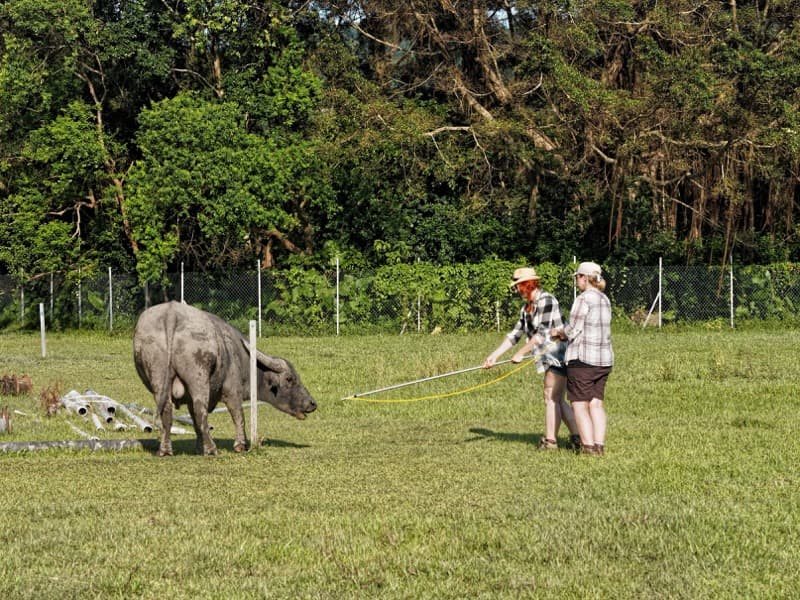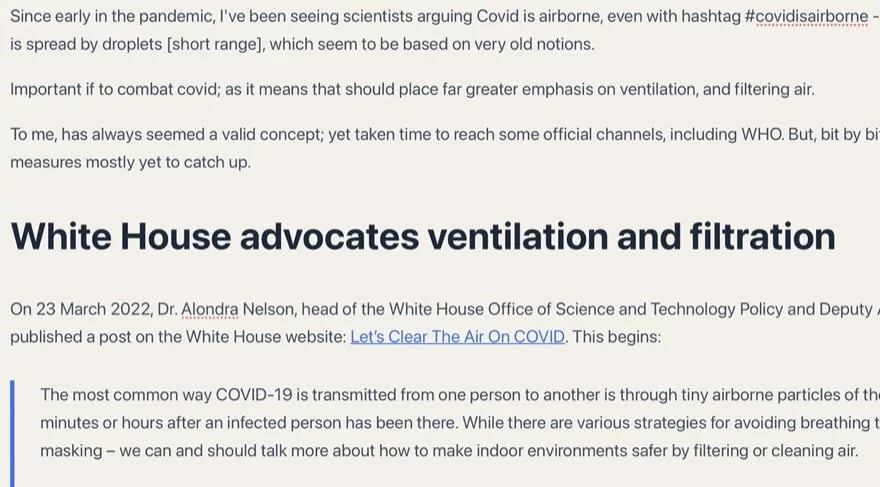A quest with implications for the future of life as we know it

On a fiercely hot summer afternoon at Pui O, on Hong Kong’s Lantau Ilsnad, a man in a maroon t-shirt and brown cap and a woman in check shirt with flaming red hair walk stealthily towards a grazing water buffalo. The man holds out a metal pole perhaps two metres long, pushing it forwards, near to the buffalo’s head. A slender rubber tube is fixed to the end of the pole nearest the buffalo, and leads back to a clear plastic bag held by the woman.
This is no regular plastic bag, but is specially leak-tight, with a connector to a pump the woman also holds. She turns on the pump, there’s a low hum from a motor, and the bag begins to inflate. Perhaps irritated by the sound, the buffalo ambles forward, leaving the two humans squelching in the marsh.
“Hold it there – its breath is still in the air,” advises a man who’s watching intently from dry land alongside. Bespectacled, blue shirted and with short-cropped grey hair beneath a snazzy red bush hat, this is Dr Euan Nisbet, geologist turned atmospheric scientist, and leader of a five-person team from the UK, visiting Hong Kong to reveal some of the mysteries of methane.
Following a buffalo around and trying to catch its breath in a plastic bag may seem an odd way of revealing the mysteries of anything. And if this strikes you as comical, consider that media including Smithsonian magazine wrongly reported that Nisbet suggested that, long before humans first set fuels on fire, dinosaur farts caused global warming (spoiler alert: it was dinosaur belches, not farts). But this is part of painstaking detective work taking Nisbet and his team across the world – from the Arctic to Amazonia and Hong Kong, sampling on foot, on ships and on planes. And the results of their work have implications for the future of life as we know it.
One of the four main greenhouse gases
Methane is the simplest of the multitude of organic chemicals known as hydrocarbons, which predominate in fossil fuels. Each molecule comprises a single carbon atom with four hydrogen atoms attached to it. As you surely know, methane is a gas. If you cook using natural gas, most of the blue flame results from methane burning – reacting with oxygen to form carbon dioxide and water.
Methane is also one of the four main greenhouse gases, along with carbon dioxide, water vapour and nitrous oxide – which ensure the earth’s atmosphere retains solar heat energy that would be otherwise emitted into space. Molecule-for-molecule, it absorbs more infrared than carbon dioxide, helping make it a more potent greenhouse gas.
It’s relatively simple to estimate methane’s role as a greenhouse gas – by measuring how much infrared it absorbs in a laboratory, and combining the result with a figure for the amount of methane in the atmosphere. But getting a detailed picture is far more difficult. This is partly because atmospheric methane is oxidised through chemical reactions, which mean that if you release methane today, the vast majority of it will be gone within nine years. Then, the amounts are in flux, as there is a complex mix of sources, including industry, natural gas exploration, vegetation rotting in wetlands, rice fields, and belching cows and water buffaloes.
With human activities playing such important roles, it is not surprising that methane levels have risen, contributing perhaps a fifth of the additional warming by greenhouse gases since pre-industrial times. Writing in Science, Nisbet and two co-authors noted that the growth rate of atmospheric methane slowed in the late 1990s, and the total amount was nearly constant from 1999 to 2006. But strong growth resumed in 2007 – and no one knows why. It’s the search for answers that brings Nisbet to Hong Kong, and Lantau.
The geologist who became a gasbuster
 If you consider his early career focused on ancient volcanic rocks, Nisbet might seem an unlikely prospect to lead a squad of global Gasbusters. Yet his ancestry, history and widely enquiring mind have made him uniquely suited to the role.
If you consider his early career focused on ancient volcanic rocks, Nisbet might seem an unlikely prospect to lead a squad of global Gasbusters. Yet his ancestry, history and widely enquiring mind have made him uniquely suited to the role.
“I was born in the ruins of Germany, and grew up in South Africa and Zimbabwe,” says Nisbet. “I went to university in Zimbabwe, for six months, and did badly.” Luckily for Nisbet, a millionaire had left money to cover scholarships for people in Zimbabwe, and he gained a scholarship to study at Cambridge University, UK. He initially read physics, but his interest changed.
“My great grandfather, Andre Geddes Bain, was the first geologist in Africa – I’ve got a Bushman painting of him,” says Nisbet. “I got more and more interested in geology, and shifted to this in my final year.”
Nisbet then studied for a PhD, mapping rock formations in Greece, before postdoctoral work with Oxford University took him back to Zimbabwe. “I had a wonderful period working there, looking at early volcanic rocks and early life,” recalls Nisbet. “There were interesting volcanic rocks; some were nearly three billion years old. If you picked them up they appeared fairly recent.”
He followed with a professorship at the University of Saskatchewan, central Canada. This gave him an opportunity to roam the Arctic tundra, and see what may have been symptoms of climate change. “I walked and saw bubbles coming up – and wondered: What are the bubbles doing?” he says. The bubbles included methane from decomposing vegetation, and Nisbet realised he could study this using isotopes – variants of an element differing only in their atomic weight – much as he had studied early life forms known as stromatolites, and shed light on earth’s environment almost three billion years ago.
Looking at methane like this would mean studying the earth right now, and gaining insights into what may happen in a future that’s just years and decades away. By doing so, Nisbet shifted from pure geology, to environmental issues. In this, too, he was influenced by his family background.
“My family were foresters and environmentalists in South Africa,” says Nisbet. “One of my great grandfathers was the chief conservation forester for South Africa, before World War One, and with another great grandfather founded the botanic garden in Cape Town. My father was a southern Presbyterian, and was concerned about our guardianship of the environment.”
Nisbet says he became more and more worried about what was happening to the planet: “I became aware of climate change in the 1980s, especially when I saw ice core data [from Antarctica and Greenland]. It was very clear greenhouse gases and temperature are very closely linked.” He wrote a book, Leaving Eden, published by Cambridge University Press in 1991 and billed as, “A wide-ranging survey of what is arguably the greatest challenge facing humanity today: the preservation of the natural environment.”
To Nisbet, our response to this challenge is, “Fundamentally down to human choices; whether we see ourselves as guardians or exploiters of the environment. Even economics should be about stewardship, but we sometimes tend to forget this, and focus on making money.”
No, not dinosaur farts – eructation!
Nisbet’s current concerns centre on budgets involving carbon rather than dollars and cents. “The Venusians have lost all their carbon to the atmosphere,” he says. Not that there are actually any Venusians of course, not with the surface temperature at 500C thanks to global warming so extreme that the oceans have evaporated. On earth, by contrast, most carbon has been precipitated out in the form of limestone, and coal, leaving carbon dioxide and a little methane – with temperatures suitable for life. “The system runs rather well,” Nisbet remarks.
But with humans adding to greenhouse gases, the system is increasingly out of kilter, and global temperatures are rising. There’s extensive research into carbon dioxide, partly as so much is generated, also as it’s relatively stable in the atmosphere – add some today, and part of it will still be there thousands of years later. Plus, carbon dioxide is believed to be the key driver of temperature change, though Nisbet helped show methane could play a sudden, transformative role.
As he began studying methane, Nisbet also realised that huge amounts of it is locked in a form of ice known as methane hydrate, or clathrate. This is plentiful beneath Arctic permafrost, and in places deep in the oceans. He wrote a paper suggesting a massive release of methane from hydrate could have played a role in ending the last ice age – resulting in a burst of warming that spurred more changes, in turn leading to our current inter-glacial period.
Others then looked at methane hydrate, and there were notions that we too might be threatened by a sudden release causing abrupt climate change. A term was coined for this catastrophic peril: “clathrate gun”.
Happily, Nisbet believes there is no imminent danger from methane hydrate. This is because one of his team members, Rebecca Fisher, has analysed the methane emerging from deep sea sources, and found that it didn’t reach the atmosphere. And although methane dominated the Deepwater Horizon blowout in the Gulf of Mexico, in 2010, most was similarly oxidised before it could getting to the surface.
Nisbet now leads the atmospheric methane group at Royal Holloway University of London. Much of the work is painstaking, unglamorous, rarely attracting attention outside the scientific world. But there was that paper on dinosaurs by Nisbet and two coauthors, in which they reported, “Our calculations suggest that sauropod dinosaurs could potentially have played a significant role in influencing climate through their methane emissions.”
Even Fox News took an interest in this idea, twisting it to write, “Dinosaurs may have farted themselves to extinction, according to a new study from British scientists.”
Smithsonian magazine duly stepped in with a correction: “A new study claims dinosaur farts contributed to prehistoric climate change, but don’t believe reports that they gassed themselves to death.” Yet here, too, they erred in writing of flatulence.
When I mention this to Nisbet, by email, he curtly notes: “Sauropod eructation? – front end!” There’s a new word for me here; and while it seems fancy I find it simply means belching.

And it’s eructation that brings Nisbet and his team to Pui O. Ruminants like cattle, especially, are well known for producing methane while digesting plant material. But with most data from northern areas in the West, Nisbet wants samples from tropical Asia, and Hong Kong makes a good place for collecting them.
After capturing some buffalo breath in a bag, the team seal the bag, assign it a code linked to notes on time, wind speed and more, and carefully place it together with other precious samples … in a reusable shopping bag. Later, the bags will be put in boxes and posted back to the university, for analyses to determine the ratios of the carbon isotopes – which should be like signatures for tropical Asian buffaloes.
There are two stable isotopes of carbon – known as Carbon-12 and Carbon-13, after their atomic weights. “Biology grabs Carbon-12 more easily than Carbon-13,” says Nisbet. “The reactions work better than with the heavier atoms.” This in turn means that methane from a biological source is “lighter” – with a higher proportion of Carbon-12 – than you would find from burning fossil fuels or natural gas leaks.
When methane levels rose in the 1980s and 1990s, there was a shift towards the heavier isotope, neatly dovetailing notions the key sources were natural gas and fossil fuel burning. But the current rise is different. “There’s a shift to significantly lighter methane, including when levels went up dramatically in 2014,” says Nisbet. “What’s been driving increase? It’s clearly a biogenic source, and as growth tends to be tropical and in the southern hemisphere, it’s probably cows or rice fields, or tropical wetlands.”
Nisbet’s favoured culprit is South American wetlands, but he still needs data from east Asia to help make sure. In addition to the buffalo escapade, his team sample confiding cattle at another location, and head to two of Hong Kong’s rice farming areas, Yi O and Hok Tau.

“Mad dogs and Englishmen!” Nisbet announces during the Yi O visit, quoting from the Noel Coward song on the foibles of going out to the midday sun. It’s indeed scorching – well over 30C in the shade according to a team thermometer, but today, Nisbet likes it hot, as there’s the best chance of capturing methane.
Scrutinising one of the paddies, Nisbet remarks “Bubbles!” almost as excitedly as a character in Finding Nemo. He deploys the steel tube and thin hose, while Rebecca Brownlow – of the flaming hair – duly pumps the air into a bag.
“Sample number two is ‘Drainage ditch below rice fields’; and I see bubbles in it,” says Nisbet. “I’m desperate to get something with methane.”
Sample bags are filled with air from close above the water, from two metres higher, and from nearby mangroves. Reusable shopping bags are filled with sample bags, and Rebecca Fisher meticulously notes identification codes along with exact locations, temperatures, wind speeds and more.
The team also have a car equipped for methane sampling. From outside, it seems to just have a rather strange roof rack, but in the back there’s a hefty piece of equipment that effectively “sniffs” incoming air and sends a real time readout to a laptop screen. At Hok Tau, Fisher proudly shows me an image from this: a red line marks their route on a Google Map, and there’s a great spike that appeared as they passed a public toilet, where a truck was just pumping out the septic tanks. Nisbet too seems delighted to have such a record of what many of us might simply rate as putrid stinking poop.
We’re hooked on “heroin”
But then, methane is hardly the most glamorous of chemicals, and dubbed marsh gas for being closely linked to decomposition. It is, however, hugely important.
“Methane will be addressed in the book I am writing now, Sophie’s Planet, which describes the fxxking mess that we are leaving for young people,” Dr James Hansen – former head of the NASA Goddard Institute for Space Studies, who has done much to inform the world about global warming – informs me by email. “We will need to get a major reduction of atmospheric CH4 amount, pushing it back closer to its preindustrial level. That is possible, but it requires quantitative understanding of all major methane sources.”
Drew Shindell, Professor of Climate Sciences at the Nicholas School of the Environment, Duke University, adds via email: “I think we need to simultaneously clarify to policy makers both WHY and HOW they should reduce methane, via quantifying the many damages resulting from emissions and documenting where they’re coming from and what technologies and policies could reduce them. Nisbet’s work is an important part of the latter, along with satellite data, etc.”
When Nisbet wrote Leaving Eden over 25 years ago, climate change due to human activities was largely a theory. But its fingerprint has become increasingly evident. Indeed, Nisbet’s team was here during a record spell when daily maximum temperatures at the Hong Kong Observatory soared above 35.0 degrees for four consecutive days, in Hong Kong’s second hottest June on record. Globally, this was the hottest June on record, and the 14th month in a row to break previous records.
Shortly after returning to London, Nisbet sent me a new paper by US researchers, who have found that the world’s clouds are shifting towards the poles and reaching higher into the atmosphere. The results had been predicted by some models, and the shifting clouds could themselves exacerbate global warming.
We all know, of course, that a key solution to global warming would be to stop using fossil fuels. But Nisbet reflects that a sudden halt would be devastating to humans: “Without oil, for 90% of the world, there would be no ploughing, no food transport. If we stopped tomorrow, it would kill five to six billion people; the carrying capacity without fossil fuels is at most one billion.”
Nisbet believes it would be better to stop oil ex;oration, and run down major sources, while striving for alternatives – which won’t be easy. “We’re hooked on ‘heroin’, and how can we come off it?” he asks, saying this is a problem for policymakers to resolve.
Yet too many policymakers seem intent on denying or avoiding the issue. The UK just shut its climate change department, Philippine president Duterte says the country will not honour commitments it made under the Paris climate change deal, and in Donald Trump the US has a presidential candidate who asserted “The concept of global warming was created by and for the Chinese.” Here in Hong Kong, you only have to walk down a street and feel air-conditioned breezes wafting from wide open doorways to appreciate the lack of urgency over the issue.
In Leaving Eden, Nisbet warned that a policy of little action now would be followed by, “A massive forced change in our civilisation in the early decades of the next century.”
There has indeed been little action, and as greenhouse gas levels rise, we face ongoing climate changing – perhaps spurred by occasional blips in methane emissions. “Standing on Svalbard [a Norwegian archipelago] and seeing ice all around, it’s hard to believe it can change – but it will,“ Nisbet reflects. “I can see Mediterranean countries putting a barrier at Gibraltar. I can see climate conflicts coming.”
Written for the South China Morning Post magazine.
Early warnings of climate change
While climate change resulting from human activities might seem a new-fangled concept, there have been on-point predictions dating back many years.…
Ignoring Science Makes Global Climate Disaster as Inevitable as Titanic Submarine Implosion
Climate change has been prominent in worldwide news this summer (2023), notably as we have just lived through the hottest week…
Have you been bullied into health? Fear, quackery and Covid
So here we are with our modern-day wonder, the internet – where even with a smartphone, you can search for and…
Never mind the antimask-o-sphere. Science shows face masks help reduce Covid spread
Just had one of those silly Twitter “conversations” with someone who had position so fixed, impossible to change with facts. Yeah,…
A Covid scrapbook: snapshots from the crazy pandemic
I’ve read accounts of the Spanish Flu, which was the last major pandemic, mainly in 1918 [so over and done with…
Highly pathogenic bird flu variants mostly evolve in intensive poultry farming
Highly pathogenic bird flu variants evolve from regular, low pathogenic, bird flus, within intensive poultry farming.
Keep Your Underpants Duck Taped and Air Clean as Covid Wild Ride Continues
We’ve learned a lot about Covid, even developing vaccines. Yet Covid remains an issue, no matter how much we might wish…
Covid is airborne so ventilation and air filtration are important
Since early in the pandemic, I’ve been seeing scientists arguing Covid is airborne, even with hashtag #covidisairborne – including to counter…
Long Covid – info and links indicating major impact
Evidence is snowballing that Long Covid is also a serious issue, even affecting people in whom the disease initially appeared mild.
Perhaps Covid arose through lab leak of tweaked bat Coronavirus
Maybe humans tweaked bat coronaviruses in gain of function experiments, inadvertently creating Covid thro lab leak.
The Covid Conundrum: Endless Lockdowns, Let It Rip … or What?
Covid is airborne, which means that much as unprotected sex is a risk for HIV, unprotected breathing might result in Covid.
Science shows Covid including Omicron is Really Not the Flu
Some of the science showing Covid including Omicron is a huge issue; and one that looks set to be with us…
“Alarmist” Covid predictions outperform Covid deniers’ soothsaying
The disinfo downplaying Covid is often from rightwing, mainly money-minded folks who perhaps don’t care too much about actual people.
Covid virulence, vaccines and variants
Science can provide some insights into what may happen with Covid, along with ways to limit its impacts.
We’re in the Covid Era for the Long Haul
We’re in this for the long haul, with the virus like a relentless, invisible foe, ready to exploit errors, slip through…
My Strange n Surprising Summer Staycation with Cellulitis
rom quick pricking by unseen marine creature, to intense fever, and hospital stay for an infection deep within the skin.
Covid virulence, vaccines and variants
[Written for South China Morning Post on 6 January 2021] In January last year, as reports were emerging of the new…
The Viral Time Bomb – Pandemic of Our Time
Guan Yi, director of the State Key Laboratory of Emerging Infectious Diseases at Hong Kong University, has extensive experience of viruses;…
From China With Fear: the Wuhan Coronavirus Won’t Kill Us All
As news of Wuhan coronavirus emerges, evolutionary biology suggests potential for a pandemic, not killing high percentage of people.
Fightback Needed as Science and Life Support System Under Attack
Environmentalism is under assault; yet this planet is the only home we have; providing our food, air, water… It’s our life…
Secret World of Hong Kong Water Supply
Hong Kong’s water supply system has been vital to its development as a “world city”.
Fusion Power and Human Failings
Several projects are underway in the quest to discover ways to harness fusion power, which is akin to a holy grail…




















Mysterious global rise in methane levels
‘
Dramatic rises in atmospheric methane are threatening to derail plans to hold global temperature rises to 2C, scientists have warned.
In a paper published this month by the American Geophysical Union, researchers say sharp rises in levels of methane – which is a powerful greenhouse gas – have strengthened over the past four years. Urgent action is now required to halt further increases in methane in the atmosphere, to avoid triggering enhanced global warming and temperature rises well beyond 2C.
“What we are now witnessing is extremely worrying,” said one of the paper’s lead authors, Professor Euan Nisbet of Royal Holloway, University of London. “It is particularly alarming because we are still not sure why atmospheric methane levels are rising across the planet.”’
https://www.theguardian.com/environment/2019/feb/17/methane-levels-sharp-rise-threaten-paris-climate-agreement
Euan Nisbet was quoted in a 7 January 2022 article in New Scientist, titled Record levels of greenhouse gas methane are a ‘fire alarm moment’:
//“It is scary,” says Euan Nisbet at Royal Holloway, University of London. He says the record shows the importance of more than 100 countries acting on their methane-cutting pledge at the COP26 climate summit.//
Read more: https://www.newscientist.com/article/2303743-record-levels-of-greenhouse-gas-methane-are-a-fire-alarm-moment/#ixzz7Hrg8UXWA
Euan Nisbet also quoted in this article:
Methane much more sensitive to global heating than previously thought – study
Article by Euan Nisbet, based on new research he and colleagues have conducted, suggests current rise in methane levels could be an indicator of significant change in climate that is underway:
//Methane fluctuated widely in pre-industrial times. But its increasingly rapid growth since 2006 is comparable with records of methane from the early years of abrupt phases of past termination events, like the one that warmed Greenland so dramatically less than 12,000 years ago.
…
Roman numerals IX to I denote past great climate transitions. There is no Roman number zero, but then any future termination-scale transition will be different – a temperature step from our present interglacial climate to some new future that is warmer yet. Methane’s signal is still unclear, but the question remains: has Termination Zero begun?//
https://theconversation.com/rising-methane-could-be-a-sign-that-earths-climate-is-part-way-through-a-termination-level-transition-211211
The research is covered in a lengthy paper, which was published in July 2023.
//Key Points
The rapid growth in the atmospheric methane burden that began in late 2006 is very different from methane’s past observational record
Recent studies point to strongly increased emissions from wetlands, especially in the tropics
This increase is comparable in scale and speed to glacial/interglacial terminations when the global climate system suddenly reorganized//
Atmospheric Methane: Comparison Between Methane’s Record in 2006–2022 and During Glacial Terminations https://agupubs.onlinelibrary.wiley.com/doi/full/10.1029/2023GB007875